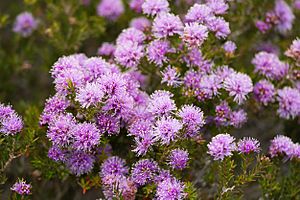Swamp honey-myrtle facts for kids
Quick facts for kids Swamp honey-myrtle |
|
|---|---|
 |
|
| M. squamea (flowers) in the Southwest Conservation Area, Tasmania, Australia | |
| Scientific classification | |
| Genus: |
Melaleuca
|
| Species: |
squamea
|
The Melaleuca squamea, often called swamp honey-myrtle, is a cool plant from the myrtle family (Myrtaceae). It grows only in certain parts of southeastern Australia, especially in Tasmania. This plant is a tall shrub that likes wet, swampy places. It has lots of leaves packed together and many pink to purple flowers that bloom in spring.
Contents
What the Swamp Honey-Myrtle Looks Like
The swamp honey-myrtle is usually a shrub that grows up to 2 m (7 ft) tall. Sometimes, it can even reach 6 m (20 ft)! It has bark that feels rough or scaly, like cork. Its branches are quite stiff and grow upwards.
Leaves
The leaves of this plant are arranged one after another along the stem. They are about 4.5–12 mm (0.2–0.5 in) long and 1–3 mm (0.04–0.1 in) wide. They are crowded together and are shaped like a narrow egg, tapering to a soft, pointy tip. Each leaf has three to five veins running along its length.
Flowers and Fruit
The flowers are usually a pretty lilac or mauve color, but sometimes they can be white or yellowish. They grow in bunches or short spikes at the ends of the branches. Even after the flowers bloom, the branches keep growing! Each bunch can have anywhere from 3 to 26 individual flowers and can be up to 20 mm (0.8 in) across.
The petals are small, about 1.5–3 mm (0.06–0.1 in) long, and they fall off as the flower gets older. Inside the flower, there are five groups of stamens (the parts that make pollen), with 4 to 9 stamens in each group.
The swamp honey-myrtle flowers in spring. After the flowers, it produces woody, almost round fruits called capsules. These capsules are about 3.5–7 mm (0.1–0.3 in) long. What's cool is that these capsules stay closed on the stems for several years!
How it Got its Name
The scientific name Melaleuca squamea was first officially described in 1806 by a scientist named Jacques Labillardière. He wrote about it in his book Novae Hollandiae Plantarum Specimen.
The second part of its name, squamea, comes from a Latin word, squama, which means "scale." This name was chosen because of the scaly bark on this plant.
Where the Swamp Honey-Myrtle Grows
This type of melaleuca is found all over Tasmania. You can also find smaller, separate groups of them in southeastern South Australia, southwestern Victoria, and near the coast in New South Wales. In New South Wales, they grow from the Tweed River down to the Royal National Park. It likes to grow in open, shrubby areas that are damp or swampy.
Using the Swamp Honey-Myrtle in Gardens
The Melaleuca squamea is a great plant to use in gardens. It can be planted to create a screen or as a background plant in your yard. It's tough because it can handle both frost (cold weather) and drought (dry periods). It also does well in soil that doesn't drain very well. However, it doesn't like soils that have a lot of lime or salt. This plant prefers a sunny spot to grow best.

